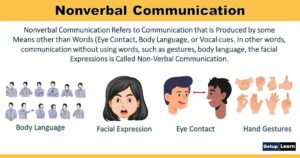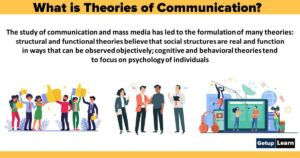Table of Contents
What are the Types of Communications?
Communication is the act of transmitting information, ideas, and attitudes from one person to another. Thus communication takes place among individuals, belonging to various categories and backgrounds, they put into operation various types of communication.

Table of Contents
7 Types of Communication
Communication takes place at different levels and accordingly we can speak of different types of communication:
- Verbal Communication
- Non-Verbal Communication
- Written Communication
- Visual Communication
- Feedback Communication
- Mass Communication
- Group Communication

Verbal Communication
In verbal communication words of a particular language are used for passing the message. For example, while teaching in a class teacher speaks, and writes on the blackboard, or sometimes, he/she may use audio/visual aids, such as the power-point to explain/emphasize certain points. All these modes come under the category of verbal communication. Thus, verbal communication is of two types.
Read More About: ????Verbal Communication: Advantages and Disadvantages, Functions????
Intrapersonal Communication
When communication takes place within oneself, it is called intrapersonal communication. It includes individual reflection, meditation, and contemplation. Intrapersonal communication includes prayers addressed to the divine though some authors describe communication with the divine as Transpersonal Communication.
Interpersonal Communication
Interpersonal communication takes place between two persons. This includes dialogue, conversation, or exchange of views between two persons without using any technological devices like the telephone. It is direct, intimate, and consists of verbal interaction or gestures.
Read More About: ????Interpersonal Communication: Elements, Importance, Principles????
Oral Communication
This is the communication that employs the spoken word, either direct or indirect as a communication channel. This verbal communication could be made on a channel that passes information in only one form i.e. sound.
Read More About: ????Oral Communication: Importance, Methods, Types, Advantages, and Disadvantages????
Public Communication
In public communication, the sender-receiver (the speaker) sends a message (the speech) to an audience. The speaker usually delivers a highly structured message, using the same channels as in interpersonal and small-group communication.
Non-Verbal Communication
Communication without using words, such as gestures, body language, the facial expressions is called non-verbal communication. Often non-verbal expressions supplement verbal communication, but it may be the only one as mentioned earlier, while giving a speech in a rally, the leader often uses gestures, to emphasize certain points. But the teacher may allow a student to enter the class simply by the gesture. Non-verbal communication is of the following types:
- Body Language (Kinesics)
- Facial Expressions
- Posture
- Gestures
- Touch
- Proxemics
- Appearance and Artifacts
- Paralanguage
Read More About: ????Nonverbal Communication: Principles, Functions, Types????
Written Communication
This kind of communication involves any kind of exchange of information in written form. To put it simply, written language communication is communication by means of written symbols that are communicated by or to, or between people or groups. Thus, written communication is the presentation of ideas or essays that make a clear point, supply details supporting that point, and demonstrate unity and coherence of thought.
When the information is lengthy and comprises images, pictures, charts, graphs, statistical data, and so forth, then it cannot be imparted orally to the individuals. In such cases, written communication is regarded as one of the indispensable ways of imparting information.
Read More About: ????Written Communication: Principal, Types, Advantages and Disadvantages????
Visual Communication
Visual communication is also the type of communication that is common in the daily lives of individuals. The main areas through which visual communication takes place are televisions, radios, social networking, and so forth. When individuals are watching television or listening to radio programs, then also they are engaged in a form of communication.
In some cases, they are not only utilizing these for leisure and recreational purposes, but they are also augmenting their knowledge and understanding in terms of various aspects. When individuals are communicating with others, then in most cases, their objective is to enhance their knowledge and understanding.
Therefore, through some television shows and radio programs as well, individuals are able to augment their knowledge and understanding. Facebook is visual with the use of memes, videos, images, and so forth. Instagram is the only image platform, and advertisers make use of this platform to market their products.
Feedback Communication
When individuals, who are in leadership positions in educational institutions and in various forms of organizations, such as instructors, supervisors, heads, directors, employers, and so forth, put into operation various types of assessment methods to evaluate the performance of the individuals.
After evaluating the performance, they provide feedback in terms of their performance. Hence, the communication that takes place is termed feedback communication. . Therefore, within educational institutions at all levels and various types of organizations, this type of communication is regarded as crucial and beneficial.
Mass Communication
Mass Communication is the process of delivering information, ideas, and attitudes to a sizeable and diversified audience. This is done through the use of media developed for that purpose namely newspapers, magazines, radio, television, websites, and social media networks. The act of mass communication is much more complex than that of face-to-face communication. It is addressed to the masses, to an extremely large audience.
Read More About: ????Mass Communication: Functions, Characteristics, Types, Importance, and Process????
Group Communication
Communication by many persons in a face-to-face situation is described as group communication. Here, as the group grows in size communication tends to become more and more of a monologue reducing participation. The degree of directness, therefore, depends on the size of the group, the place where it meets, and also the relationship of the members of the group to one another. In a group, communication feedback is more difficult to measure and respond to.
Read More About: ????Group Communication: Meaning, Importance, Advantages, Disadvantages, Characteristics????
Read More Related Articles
[su_spoiler title=”What is Communication? | Mass Communication” style=”fancy” icon=”plus-circle”]
What is Communication?
[/su_spoiler]
[su_spoiler title=”Types of Communication | Principles of Communication” style=”fancy” icon=”plus-circle”]
Types of Communication
-
Types of Communication
- Verbal Communication
- Non-Verbal Communication
- Written Communication
- Visual Communication
- Feedback Communication
- Mass Communication
- Group Communication
[/su_spoiler]
[su_spoiler title=”Nonverbal Communication | Verbal Communication” style=”fancy” icon=”plus-circle”]
[/su_spoiler]
[su_spoiler title=”Written Communication | Oral Communication” style=”fancy” icon=”plus-circle”]
Written Communication
[/su_spoiler]
[su_spoiler title=”Business Communication | Organizational Communication” style=”fancy” icon=”plus-circle”]
[/su_spoiler]
[su_spoiler title=”Formal Communication | Informal Communication” style=”fancy” icon=”plus-circle”]
[/su_spoiler]
[su_spoiler title=”Interpersonal Communication | Informal Communication” style=”fancy” icon=”plus-circle”]
Interpersonal Communication
[/su_spoiler]
[su_spoiler title=”Downward Communication | Upward Communication” style=”fancy” icon=”plus-circle”]
[/su_spoiler]
[su_spoiler title=”Barriers to Communication | Horizontal or Lateral Communication” style=”fancy” icon=”plus-circle”]
[/su_spoiler]
[su_spoiler title=”Self Development | Effective Communication” style=”fancy” icon=”plus-circle”]
[/su_spoiler]
[su_spoiler title=”Difference Between Oral and Written Communication | Theories of Communication” style=”fancy” icon=”plus-circle”]
[/su_spoiler]
What are the 6 types of communication?
These 6 types of communication are Verbal, Non-Verbal, Written, Visual, Feedback, Mass, Group Communication, etc.
What is verbal communication give examples?
In verbal communication words of a particular language are used for passing the message. For example, while teaching in a class teacher speaks, and writes on the blackboard, or sometimes, he/she may use audio/visual aids, such as the power-point to explain/emphasize certain points. All these modes come under the category of verbal communication. Thus, verbal communication is of two types.
What are the examples of visual communication?
Visual communication is also the type of communication that is common in the daily lives of individuals. The main areas through which visual communication takes place is televisions, radios, social networking, and so forth. When individuals are watching television or listening to radio programs, then also they are engaged in a form of communication.















